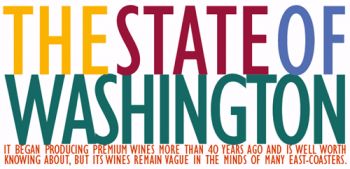Wines of Washington State
First
we must disentangle the state in the upper left corner of
the country from the often unreal city on the bank of the
Potomac. (There are 47 different Washingtons listed in the
index to my atlas.) Next we must understand that,
climatically, there are two Washington States. The more
familiar western third, containing Seattle, is too moist for
prime wine growing. The arid two-thirds of the state east of
the Cascade Mountains, with the necessary help of irrigation
from the huge Columbia River basin, accommodate seemingly
endless vineyards producing all manner of fine
grapes.
Washington,
second among the states in wine production, now contains
more than 3O,OOO acres of producing vineyards and more than
3OO wineries. (It seems a new one opens every week.) It has
established its own style vis-a-vis the California behemoth
to the south, as we’ll see when investigating the wines of
our focus – Hogue Cellars. Because of the northerly
location, there are long hours of sunlight during the
growing season, fostering full flavor development in the
grapes. Humidity is low because of the rain shadow of the
Cascade Range to the west, so rot and other diseases and
pests are minimized. Phylloxera is not a problem in
Washington, perhaps a result of cold winters and sandy soil,
thereby permitting vines to be planted on their own roots.
During the growing season, days are warm, nights chilly. The
wide day/night temperature swing ensures that the grapes
develop sugars and fruit flavors amply balanced by vital
enlivening acids. Soils are mostly volcanic, sandy, and
sandy loam compositions, low in nutrients and providing good
drainage. A wide variety of grape varieties do
well.
Hogue Cellars is
about the third largest of Washington’s wine producers,
putting forth nearly 6OO,OOO cases annually. The winery is
in Prosser, along the Yakima River. About 2OOO acres of
vineyards, either owned or with long-term contracts, are
strategically scattered through the Columbia Valley
subdivisions. Before getting into the wines, let’s gain
perspective by briefly reviewing Hogue’s history.
Wayne Hogue, a
hop farmer, and his wife, Shyla, bought 😯 acres of hops in
the Yakima Valley in 1948, later expanding holdings, and,
with younger son Mike, adding apples, Concord grapes,
asparagus, mint, and other crops. Older son Gary, who
pursued a career in construction materials, returned to the
family business when Mike, who had planted wine grapes in
1974 (sold to other wineries), began making wine
commercially in 1982. Numerous awards have catalyzed
continuing expansion. Hogue Cellars was purchased by Vincor
International in 2OO1 – the staff, however, has remained
largely in place.
Wayne Hogue, now
about 86-years-old, at last report plays golf almost every
day. Shyla died last fall. Mike continues farming but is no
longer involved with the winery. Gary is responsible for
sales and marketing of wines.
David Forsyth,
Director of Winemaking, earned a master’s degree in enology
at UC Davis, worked at Vose Vineyards in the Napa Valley,
then joined Hogue in 1984, where he has been involved in
making wine ever since. Wade Wolfe, Vice President of
Production and winegrowing, holder of a Ph.D. from Davis in
grape genetics, came to Hogue in 1991 from Chateau Ste.
Michelle, where he directed vineyard operations. He and his
wife own the small Thurston-Wolfe Winery in
Prosser.
Hogue wines are
divided into four lines. Fruit Forward wines are as
described. Most of them are fermented at cool temperatures
in stainless steel. They are straightforward wines that
retail for $8 to12. The wines called Genesis by Hogue, named
for Mike Hogue’s first vineyard, emphasize varietal
characteristics. They are made from grapes selected by
vineyard site and microclimate to this purpose and aged in
American and French oak of mixed ages. They retail for $15
to 18. The Reserve wines, of limited production, are made
from strictly selected grapes grown at prime sites, and
undergo extended aging, primarily in new French oak barrels.
Their retail cost is $23 to 3O. Right now, there are two
wines in the Terroir line, which are very limited in
quantity and sold only at the winery. They are unusual wines
from unusual sites. The Lemberger 2OO1 costs $2O to 25, and
only 56 cases were made. The Sangiovese 2OO1 costs
$25.
|
me now share my recent tasting experience. FRUIT JOHANNISBERG GEWURZTRAMINER PINOT CHARDONNAY Cabernet-Merlot NOT
GENESIS SYRAH MERLOT CABERNET NOT
RESERVE MERLOT CABERNET TERROIR LEMBERGER
Hogue’s wines are interestingly varied, zesty in |

